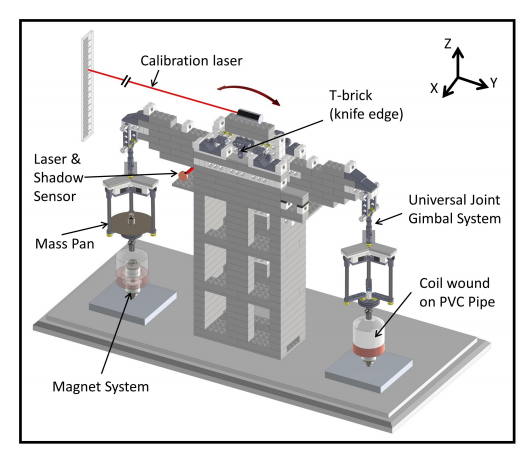How to Measure Planck’s Constant Using Lego
Planck’s constant is one of the most important numbers in science. It describes the relationship between the energy and frequency of an electromagnetic wave in an equation known as the Planck-Einstein relation: E = hv (where E is energy, v is frequency and h is Planck’s constant).

This constant is set to become even more important because physicists are about to change the definition of mass so that it depends on Planck’s constant rather than on the mass of a lump of metal in a vault in Paris.
So it’s not surprising that physicists need various ways to measure mass based on Planck’s constant or, conversely, finding a value of Planck’s constant based on a known mass. Today, Leon Chao at the National Institute of Standards and Technology in in Gaithersburg, Maryland, and a few pals, explain how to do this using an experiment built out of Lego.
Over the years, physicists at the National Institute of Standards and Technology have evaluated various different ways of carrying out this measurement and have settled on an experiment using a machine known as a watt balance.
This device is simple in principle. The idea is to balance the force on a mass due to gravity with the force generated by a current carrying coil in a magnetic field. The mass can then be calculated in a straightforward way by comparing the mechanical power to the electrical power involved in the experiment (the machines gets its name because electrical and mechanical power are both measured in watts).
The experiment involves measurements of only of the voltage and current through the coil as well as the velocity of the mass as it moves through the coil. It also requires an accurate value for g, the acceleration due to gravity, which can be easily read off a website operated by the National Oceanic and Atmospheric Administration by entering any location on the planet.
Planck’s constant comes in because of an historical idiosyncrasy in the way power units have been defined. Since 1990, almost all electrical measurements have been calibrated using a system of units in which Planck’s constant, along with various other constants, are defined rather than measured.
By contrast, mechanical power relies on ordinary SI units, which rely on a measured value of Planck’s constant. “By comparing electrical power in conventional units to mechanical power in SI units, h can be determined,” say Chao and co.
All that is needed is a working watt balance and Chao and co describe how to build one using Lego, even providing a comprehensive parts list, much of which can be ordered from Lego’s Pick-a-Brick website. They also give websites for purchasing other more specialist components.
The total cost of these parts is $634 but savings are possible. The most expensive component by far is a $300 data acquisition device followed by a $90 analogue output. Chao and co say these can both be replaced by single device costing only $189, thereby saving $200.
That puts the cost well within reach of many schools and even private individuals. “We hope to encourage many enthusiasts to build a LEGO watt balance and have fun toying with the science of measurement, metrology,” say the team.
With the holiday season just around the corner, many readers may find themselves hunting for gifts for significant others. A watt balance kit could be the perfect present for the physicist who has everything.
Ref: http://arxiv.org/abs/1412.1699 : A LEGO Watt Balance: An Apparatus To Demonstrate The Definition Of Mass Based On The New SI
Keep Reading
Most Popular
Large language models can do jaw-dropping things. But nobody knows exactly why.
And that's a problem. Figuring it out is one of the biggest scientific puzzles of our time and a crucial step towards controlling more powerful future models.
The problem with plug-in hybrids? Their drivers.
Plug-in hybrids are often sold as a transition to EVs, but new data from Europe shows we’re still underestimating the emissions they produce.
How scientists traced a mysterious covid case back to six toilets
When wastewater surveillance turns into a hunt for a single infected individual, the ethics get tricky.
Google DeepMind’s new generative model makes Super Mario–like games from scratch
Genie learns how to control games by watching hours and hours of video. It could help train next-gen robots too.
Stay connected
Get the latest updates from
MIT Technology Review
Discover special offers, top stories, upcoming events, and more.